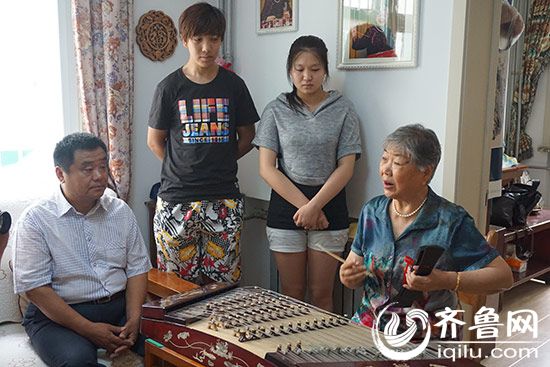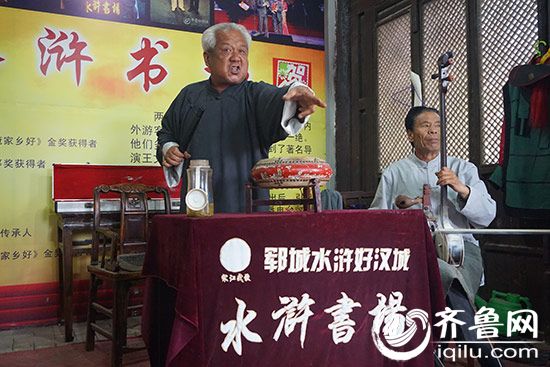source: Qilu network Author: Cai Xiaotong
this morning, the eight session of the eleven Standing Committee of the CPPCC Shandong provincial CPPCC was opened in Ji'nan. Qilu network reporter Cai Xiaotong /

National non material cultural heritage project Shandong piano inheritor Li Xiangyun and his disciples are practising at home. Qilu network reporter Cai Xiaotong / photographed

non material cultural heritage successor Wang Heyi in Yuncheng Water Margin good Seoul performance pendant. Qilu network reporter Cai Xiaotong /
Qilu network Ji'nan July 1st (reporter Cai Xiaotong intern reporter Xu Kuoqun) this morning, the eight CPPCC National Committee of the CPPCC National Committee of the eleven session of the opening of the Ji'nan. Xu Xianghong, Vice Minister of the Propaganda Department of the provincial Party committee and director of the provincial cultural department, informed Shandong about the protection and inheritance of historical culture in the process of urbanization. The Qilu network reporter learned at the meeting that the regulations on the protection of intangible cultural heritage in Shandong has entered the legislative procedure. The people's government at the county level and above will protect the non material cultural heritage representative projects in the urban and rural planning and construction.
Shandong proposed "seven zones and two belts" to invest 1 billion yuan to protect cultural heritage
recently, the Grande Canale has succeeded and became the forty-sixth world heritage project in China. It is understood that there are 10 national historic and cultural cities in Shandong (Ji'nan, Qingdao, Liaocheng, Zibo, Yantai, Tai'an, Qufu, Zoucheng, Penglai, Qingzhou), 16 national traditional villages, 196 national key cultural relic protection units, and 153 national non material heritage projects.
Xu Xianghong said that Shandong's rich cultural heritage resources are important support for the development of cultural tourism and cultural industries. Since "12th Five-Year", the province has carried out salvage maintenance and protection for more than 180 relics, arranged the state and provincial finance department for 700 million yuan, and completed 71 maintenance projects. Qufu "three holes", Taishan, Penglaige, Liu Gong Dao and other key cultural relics protection units, three years to receive about 20000000 visitors to Chinese and foreign visitors, only one income last year, more than 2 billion yuan.
Shandong Province, based on the regional cultural distribution characteristics of the province, broke the existing administrative division, and put forward the strategic plan of "seven zones and two zones" (Qufu, Qufu, Taishan, the Yellow River Delta, peninsula, Yimeng, Luxi and other flanges, and the Grande Canale, Qi the Great Wall) cultural heritage protection zone, and combined with urban construction. We should plan for the development of cultural heritage protection plan in Qufu area and the construction plan of "the Grande Canale historical and cultural corridor", and focus on the 88 key projects for cultural relics protection. National, provincial and local matching funds invested nearly 1 billion yuan, benefiting more than 5 million people.
Qilu network reporter learned that the "Shandong province non material cultural heritage protection regulations" has entered the legislative process, this year, it was listed as the provincial local legislative plan of the province two types of projects, its "draft" has been completed and for the whole province to seek advice.
the regulations clearly point out that the cultural form of profound historical and cultural accumulation, good survival and cultural form with important value and distinctive regional characteristics shall be protected as a whole; the people's government above the county level should be planned in urban and rural areas by the buildings, places and sites involved in the representative projects of the intangible cultural heritage. And effective measures should be taken to protect it.
supports the "Apprentice skills": at least 3 apprentices from each inheritor
the shortage of local opera talents is a major problem for Shandong. At present, there are more than 300 local operas in China, with an average of one drama perishing each year. Before the cultural revolution, there were 34 operas in Shandong. At present, there are only 24, and there are only more than ten regular performances, including nine "the first regiment in the world".
according to the latest investigation of the Shandong Academy of Arts and art, there are only 10 remaining pieces of musical art in the whole province.
China has 60 current national successors, 324 provincial successors. Each year, the national representative inheritor's central finance is given 10 thousand yuan per year, and the provincial representative provincial finance person is given a subsidy of 6000 yuan per year. Xu Xianghong believes that it is urgent to protect the inheritors of intangible cultural heritage.
"Shandong has established the mechanism of inheritors' apprentice and dissemination, requiring each representative inheritor to receive at least 3 apprentice." Xu Xianghong said, at present, the province's representative successors at all levels have 12390 apprentice. In addition, a total of more than 1300 training courses were held in the province, and more than 100 thousand people were trained at all levels.
Qilu network reporter learned that since 2012, Shandong has implemented the project "supporting 1000 non legacy inheritors, folk artists and apprentice" for two consecutive years, and trained all the provincial successors, and organized them into the campus, into the community, into the square, into the barracks, and into the enterprise. 23 million people in the province directly participate in cultural heritage activities related to intangible cultural heritage. "
implementation of the" rural memory "project to eliminate" a thousand village side "
" some places do not pay attention to the protection of the cultural characteristics of the city, the building greedy for ocean, monotonous! " Xu Xianghong said that in the process of urbanization, some ancient villages, ancient houses, and ancient streets with historical and cultural values have not been properly protected. On the contrary, some places are pursuing modern, beautiful and neat, completely dismantling the traditional communities and villages, or "reconstructing" the ancient buildings and ancient dwellings, which have caused the urban and rural construction "one thousand cities one side and a thousand village side".
reporters at the meeting learned that in the past 20 years, 1600 immovable cultural relics disappeared in the province, and more than half of them were destroyed by various construction activities.
Hu Ji Shu Hui is a folk art fair held in Huji Town, Huimin County, Shandong province. It is one of the two great book societies in China. Since 1990s, most young people in the rural areas of northern Shandong have gone out to work, and the way of entertainment has become increasingly diverse, resulting in the decline of Hu Ji Book society. "At the beginning of the eighth month of the seven month, we began to work. No one waited until the Lantern Festival. Xu Xianghong said that during this period, the artists who came to the storytelling dropped to the top of the three hundred files.
to this, Shandong put forward the implementation of the "rural memory" project, as an innovative attempt to explore the protection of cultural heritage in the new urbanization construction, inherit and carry forward the excellent traditional culture model.
Qilu network reporter learned that Shandong introduced folk custom ecological museum, community museum, rural Museum and other new concepts. At present, we have initially identified 24 traditional cultural townships, villages, blocks and rural community museums. In August this year, the pilot units will be listed and will be implemented in the province after the standardization standards are formed.